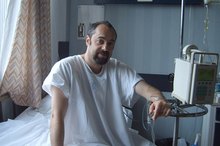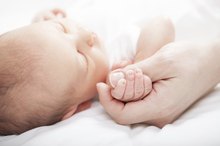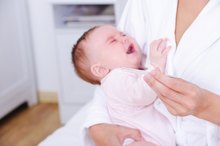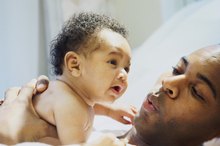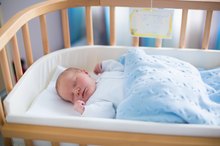Health Risks of Babies Around Chemotherapy Patients
Chemotherapy medications are powerful drugs with dangerous side effects 3. But chemotherapy patients don’t usually isolate themselves completely from babies or small children—nor should they. They should, however, use specific precautions not only to protect themselves from illnesses carried by the baby, but also to protect the baby from any ill effects from chemotherapy, including keeping chemotherapy pills far from any area where a baby could find and swallow them. Chemotherapy patients themselves do not pose a risk to babies, but babies may pose a risk to them, as direct contact with bodily fluids from chemotherapy patients can cause harm.
If you are experiencing serious medical symptoms, seek emergency treatment immediately.
Contact Risks
Chemotherapy agents are present for as long as 48 hours after treatment in bodily fluids such as urine, tears, stool or vomit, according to the Cleveland Clinic 2. Exposure to these fluids may pose a risk of absorption for an infant exposed to them. Chemotherapy drugs have also been found on the outside of vials, on floors, doorknobs and garbage cans, MSNBC reports. Chemotherapy patients should carefully wash their hands after using the toilet to avoid contamination of other surfaces. Toilets should be flushed twice or, if possible, a separate toilet should be used by the person undergoing chemotherapy. A baby visiting a patient undergoing chemotherapy should not be allowed to touch potentially contaminated surfaces in the room. If a baby comes in contact with potentially contaminated body fluids or surfaces, wash the area touched thoroughly with warm water and soap.
- Chemotherapy agents are present for as long as 48 hours after treatment in bodily fluids such as urine, tears, stool or vomit, according to the Cleveland Clinic 2.
- Chemotherapy patients should carefully wash their hands after using the toilet to avoid contamination of other surfaces.
Cancer Risks
Swimming & Chemotherapy
Learn More
Recent studies show that medical workers repeatedly exposed to chemotherapy agents may have a higher risk of developing cancer than those who don’t, MSNBC reports. While a single exposure to a chemotherapy drug probably won’t have any lasting effects, the Cleveland Clinic states, repeated exposures must be avoided. The person undergoing chemotherapy does not pose any danger to a baby.
Patient Risks
A person receiving chemotherapy has a higher than normal susceptibility to infection. A sick baby could pass bacteria or viruses on to a person going through chemotherapy. Even a cold can cause serious illness in a person undergoing chemotherapy, so a baby with even a case of the sniffles should stay away from a person receiving chemotherapy. Babies who have recently had measles, chickenpox or polio vaccines should not visit people undergoing chemotherapy, the National Cancer Institute states 3. A person undergoing chemotherapy should wear a mask to avoid airborne contamination when around a baby.
- A person receiving chemotherapy has a higher than normal susceptibility to infection.
- Even a cold can cause serious illness in a person undergoing chemotherapy, so a baby with even a case of the sniffles should stay away from a person receiving chemotherapy.
Related Articles
References
- MSNBC: Lifesaving Chemo May Put Workers' Lives at Risk
- Cleveland Clinic: Chemotherapy Precautions Before and After Treatment
- National Cancer Institute: Infection: Managing Chemotherapy Side Effects
- Schillert A, Trumpp A, Sprick MR. Label retaining cells in cancer--the dormant root of evil? Cancer Lett. 2013;341(1):73-9. doi:10.1016/j.canlet.2013.04.019
- Weeks JC, Catalano PJ, Cronin A, et al. Patients' expectations about effects of chemotherapy for advanced cancer. N Engl J Med. 2012;367(17):1616-25. doi:10.1056/NEJMoa1204410
- Pabla N, Dong Z. Curtailing side effects in chemotherapy: a tale of PKCδ in cisplatin treatment. Oncotarget. 2012;3(1):107-11. doi:10.18632/oncotarget.439
- Sreerama L. Alkylating Agents. In: Schwab M, editor. Encyclopedia of Cancer. Berlin, Heidelberg: Springer; 2011. doi:10.1007/978-3-642-16483-5_182
- Yardley DA. Drug resistance and the role of combination chemotherapy in improving patient outcomes. Int J Breast Cancer. 2013;2013:137414. doi:10.1155/2013/137414
- Modjtahedi H, Ali S, Essapen S. Therapeutic application of monoclonal antibodies in cancer: advances and challenges. Br Med Bull. 2012;104:41-59. doi:10.1093/bmb/lds032
- Gonzalez R, Cassaro S. Percutaneous Central Catheter (PICC). StatPearls Publishing. Updated February 11, 2019.
- Trüeb RM. Chemotherapy-induced alopecia. Semin Cutan Med Surg. 2009;28(1):11-4. doi:10.1016/j.sder.2008.12.001
- Hofman M, Ryan JL, Figueroa-moseley CD, Jean-pierre P, Morrow GR. Cancer-related fatigue: the scale of the problem. Oncologist. 2007;12 Suppl 1:4-10. doi:10.1634/theoncologist.12-S1-4
- Lundqvist EÅ, Fujiwara K, Seoud M. Principles of chemotherapy. Int J Gynaecol Obstet. 2015;131 Suppl 2:S146-9. doi:10.1016/j.ijgo.2015.06.011
- Joaquín-Mingorance M, Arbinaga F, Carmona-Márquez J, Bayo-Calero J. Coping strategies and self-esteem in women with breast cancer. Anales de Psicología. 2019;35(2). doi:10.6018/analesps.35.2.336941
- Nangia J, Wang T, Osborne C, et al. Effect of a Scalp Cooling Device on Alopecia in Women Undergoing Chemotherapy for Breast Cancer: The SCALP Randomized Clinical Trial. JAMA. 2017;317(6):596-605. doi:10.1001/jama.2016.20939
- Chaveli-lópez B. Oral toxicity produced by chemotherapy: A systematic review. J Clin Exp Dent. 2014;6(1):e81-90. doi:10.4317/jced.51337
- Apisarnthanarax N, Duvic MM. Photosensitivity Reactions. In: Kufe DW, Pollock RE, Weichselbaum RR, et al, editors. Holland-Frei Cancer Medicine. 6th Edition. Hamilton (ON): BC Decker; 2003.
- Brower V. Tracking chemotherapy's effects on secondary cancers. J Natl Cancer Inst. 2013;105(19):1421-2. doi:10.1093/jnci/djt273
- American Society of Clinical Oncology. Cancer.Net. Understanding Chemotherapy. Updated 05/2018.
- Longo, D. L. Harrison's Principles of Internal Medicine. 2017. New York: McGraw-Hill.
- National Cancer Institute. SEER Training Manual. Types of Chemotherapy Drugs.
- Niederhuber, J., Armitage, J., Doroshow, J., Kastan, M., and J. Tepper. Abeloff's Clinical Oncology: 6th Edition. 2019. Philadelphia: Churchill Livingstone/Elsevier.
Writer Bio
A registered nurse with more than 25 years of experience in oncology, labor/delivery, neonatal intensive care, infertility and ophthalmology, Sharon Perkins has also coauthored and edited numerous health books for the Wiley "Dummies" series. Perkins also has extensive experience working in home health with medically fragile pediatric patients.

